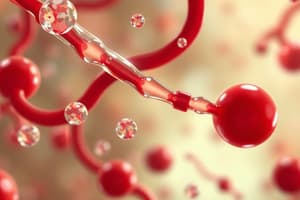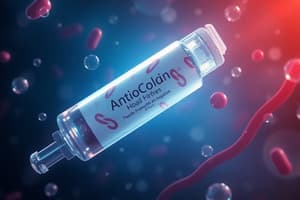Podcast
Questions and Answers
Which of the following best describes why newer direct oral anticoagulants (DOACs) like Apixaban and Rivaroxaban are gaining prominence over Vitamin K antagonists (VKAs)?
Which of the following best describes why newer direct oral anticoagulants (DOACs) like Apixaban and Rivaroxaban are gaining prominence over Vitamin K antagonists (VKAs)?
- DOACs typically require less frequent laboratory monitoring, simplifying anticoagulation management. (correct)
- DOACs have a significantly lower risk of bleeding complications compared to VKAs in all patient populations.
- DOACs have a broader range of target factors in the coagulation cascade, providing more comprehensive anticoagulation.
- DOACs are effective in a wider variety of clinical conditions and patient profiles than VKAs.
A patient with a history of heparin-induced thrombocytopenia (HIT) requires anticoagulation for an acute thromboembolic event. Which of the following anticoagulants is most appropriate for this patient?
A patient with a history of heparin-induced thrombocytopenia (HIT) requires anticoagulation for an acute thromboembolic event. Which of the following anticoagulants is most appropriate for this patient?
- Warfarin
- Heparin
- Clopidogrel
- Argatroban (correct)
Fondaparinux selectively enhances the activity of antithrombin. Which coagulation factor is primarily targeted by this mechanism of action?
Fondaparinux selectively enhances the activity of antithrombin. Which coagulation factor is primarily targeted by this mechanism of action?
- Factor VIIa
- Factor IXa
- Factor Xa (correct)
- Factor IIa (thrombin)
A patient is prescribed both aspirin and an anticoagulant medication following a cardiac stent placement. What is the primary reason for using both medications in conjunction?
A patient is prescribed both aspirin and an anticoagulant medication following a cardiac stent placement. What is the primary reason for using both medications in conjunction?
A patient on an anticoagulant is scheduled for an elective surgery. What is the most critical consideration regarding their anticoagulant therapy prior to the procedure?
A patient on an anticoagulant is scheduled for an elective surgery. What is the most critical consideration regarding their anticoagulant therapy prior to the procedure?
Which of the following best describes the mechanism of action of heparins?
Which of the following best describes the mechanism of action of heparins?
A patient is prescribed warfarin for long-term anticoagulation. What dietary advice is most important for this patient?
A patient is prescribed warfarin for long-term anticoagulation. What dietary advice is most important for this patient?
What is a key difference between unfractionated heparin (UFH) and low-molecular-weight heparins (LMWHs)?
What is a key difference between unfractionated heparin (UFH) and low-molecular-weight heparins (LMWHs)?
Which of the following is a feature of Direct Oral Anticoagulants (DOACs)?
Which of the following is a feature of Direct Oral Anticoagulants (DOACs)?
A patient is started on warfarin. How long does it typically take for warfarin to achieve its full therapeutic effect?
A patient is started on warfarin. How long does it typically take for warfarin to achieve its full therapeutic effect?
Which anticoagulant requires frequent monitoring of the activated partial thromboplastin time (aPTT)?
Which anticoagulant requires frequent monitoring of the activated partial thromboplastin time (aPTT)?
Which of the following anticoagulants has the most predictable pharmacokinetic profile, reducing the need for routine monitoring of coagulation tests?
Which of the following anticoagulants has the most predictable pharmacokinetic profile, reducing the need for routine monitoring of coagulation tests?
What is the primary reason for monitoring the International Normalized Ratio (INR) in patients taking Vitamin K Antagonists (VKAs)?
What is the primary reason for monitoring the International Normalized Ratio (INR) in patients taking Vitamin K Antagonists (VKAs)?
Flashcards
Factor Xa inhibitors
Factor Xa inhibitors
Anticoagulants that inhibit factor Xa to reduce clotting.
Direct thrombin inhibitors
Direct thrombin inhibitors
Drugs like Argatroban that directly inhibit thrombin's activity.
Fondaparinux
Fondaparinux
A synthetic pentasaccharide that enhances antithrombin and targets factor Xa.
Antiplatelet agents
Antiplatelet agents
Signup and view all the flashcards
Monitoring anticoagulants
Monitoring anticoagulants
Signup and view all the flashcards
Anticoagulants
Anticoagulants
Signup and view all the flashcards
Coagulation cascade
Coagulation cascade
Signup and view all the flashcards
Heparin
Heparin
Signup and view all the flashcards
Unfractionated Heparin (UFH)
Unfractionated Heparin (UFH)
Signup and view all the flashcards
Low-Molecular-Weight Heparins (LMWHs)
Low-Molecular-Weight Heparins (LMWHs)
Signup and view all the flashcards
Vitamin K Antagonists (VKAs)
Vitamin K Antagonists (VKAs)
Signup and view all the flashcards
International Normalized Ratio (INR)
International Normalized Ratio (INR)
Signup and view all the flashcards
Direct Oral Anticoagulants (DOACs)
Direct Oral Anticoagulants (DOACs)
Signup and view all the flashcards
Study Notes
Anticoagulant Mechanisms
- Anticoagulants prevent or delay blood clot formation, acting at various stages of the coagulation cascade.
Anticoagulant Classes: Overview
- Different anticoagulant classes have distinct mechanisms, impacting clinical use and potential side effects.
Heparins
-
Heparin encompasses unfractionated heparin (UFH) and low-molecular-weight heparins (LMWHs).
-
Mechanism of action: Heparins enhance antithrombin III, which inactivates clotting factors (thrombin and factor Xa), preventing fibrin clot formation.
-
UFH: Administered intravenously or subcutaneously, carries a higher bleeding risk than LMWH, requiring frequent aPTT monitoring.
-
LMWHs: Administered subcutaneously, with a more predictable pharmacokinetic profile, less frequent monitoring, and lower bleeding risk compared to UFH. They are not interchangeable with UFH.
Vitamin K Antagonists (VKAs)
-
Warfarin and similar drugs are VKAs.
-
Mechanism of action: VKAs inhibit the liver's synthesis of vitamin K-dependent clotting factors (II, VII, IX, and X). This delayed effect typically takes days to reach full impact.
-
Clinical use: Primarily for long-term anticoagulation, e.g., in atrial fibrillation or after venous thromboembolism.
-
Monitoring: Requires regular INR monitoring for therapeutic anticoagulation and to minimize bleeding.
-
Dietary considerations: Consistent vitamin K intake is essential for patients on VKAs, as fluctuations can alter medication effectiveness.
Direct Oral Anticoagulants (DOACs)
-
DOACs are newer anticoagulants directly blocking specific clotting factors.
-
Mechanism of action: DOACs directly inhibit either factor Xa or thrombin. They often have predictable pharmacokinetics, reducing the need for routine coagulation tests.
-
Examples: Apixaban, Rivaroxaban (Factor Xa inhibitors), Dabigatran (thrombin inhibitor), Edoxaban (Factor Xa inhibitor).
-
Monitoring: Generally require less frequent laboratory monitoring compared to VKAs, simplifying management.
Other Anticoagulants
-
Other notable anticoagulants include:
-
Direct thrombin inhibitors: (e.g., Argatroban, Bivalirudin) directly inhibiting thrombin's activity. Used primarily in specific situations, e.g., high-risk bleeding, cardiac surgery.
-
Fondaparinux: A synthetic pentasaccharide boosting antithrombin activity, particularly targeting factor Xa, minimizing heparin-related side effects.
-
Antiplatelet agents: Aspirin and clopidogrel, while not purely anticoagulants, are frequently used alongside anticoagulants to reduce clot formation.
Clinical Considerations
-
Anticoagulant choice depends on patient history, indication, and bleeding risk.
-
Careful consideration of drug interactions is critical when prescribing anticoagulants.
-
Patients should be monitored for bleeding signs (easy bruising, unusual nose/gum bleeding, blood in urine/stool).
-
Patients must be educated about side effects and precise medication adherence.
Studying That Suits You
Use AI to generate personalized quizzes and flashcards to suit your learning preferences.




